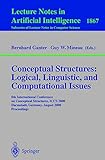Conceptual Structures: Logical, Linguistic, and Computational Issues [electronic resource] : 8th International Conference on Conceptual Structures, ICCS 2000 Darmstadt, Germany, August 14-18, 2000 Proceedings /
Material type: TextSeries: Lecture Notes in Artificial Intelligence ; 1867Publisher: Berlin, Heidelberg : Springer Berlin Heidelberg : Imprint: Springer, 2000Edition: 1st ed. 2000Description: XII, 576 p. online resourceContent type:
TextSeries: Lecture Notes in Artificial Intelligence ; 1867Publisher: Berlin, Heidelberg : Springer Berlin Heidelberg : Imprint: Springer, 2000Edition: 1st ed. 2000Description: XII, 576 p. online resourceContent type: - text
- computer
- online resource
- 9783540446637
- 006.3 23
- Q334-342
- TA347.A78
Concepts and Language -- The Role of Conceptual Structure in Human Evolution -- Concepts in Linguistics – Concepts in Natural Language -- Patterns, Schemata, and Types — Author Support through Formalized Experience -- Conventions and Notations for Knowledge Representation and Retrieval -- Conceptual Ontology -- Ontology, Metadata, and Semiotics -- Pragmatically Yours, -- Conceptual Modeling for Distributed Ontology Environments -- Discovery of Class Relations in Exception Structured Knowledge Bases -- Conceptual Graphs: Perspectives -- CGs Applications : Where Are We 7 Years after the First ICCS? -- The Engineering of a CG-Based System: Fundamental Issues -- Conceptual Graphs, Metamodeling, and Notation of Concepts -- Knowledge Representation and Reasonings Based on Graph Homomorphism -- User Modelling Using Conceptual Graphs for Intelligent Agents -- Towards a Unified Querying System of Both Structured and Semi-structured Imprecise Data Using Fuzzy View -- Formal Semantics of Conceptual Structures -- The Extensional Semantics of the Conceptual Graph Formalism -- Semantics of Attribute Relations in Conceptual Graphs -- Nested Concept Graphs and Triadic Power Context Families -- Negations in Simple Concept Graphs -- Extending the CG Model by Simulations -- Contextual Logic and Formal Concept Analysis -- Building and Structuring Description Logic Knowledge Bases Using Least Common Subsumers and Concept Analysis -- On the Contextual Logic of Ordinal Data -- Boolean Concept Logic -- Lattices of Triadic Concept Graphs -- Formalizing Hypotheses with Concepts -- Generalized Formal Concept Analysis -- A Logical Generalizationof Formal Concept Analysis -- On the Treatment of Incomplete Knowledge in Formal Concept Analysis -- Conceptual Structures in Practice -- Logic-Based Networks: Concept Graphs and Conceptual Structures -- Conceptual Knowledge Discovery and Data Analysis -- CEM – A Conceptual Email Manager -- A Contextual-Logic Extension of TOSCANA -- A Conceptual Graph Model for W3C Resource Description Framework -- Computational Aspects of Conceptual Structures -- Computing with Conceptual Structures -- Symmetry and the Computation of Conceptual Structures -- An Introduction to SNePS 3 -- Composition Norm Dynamics Calculation with Conceptual Graphs -- From PROLOG++ to PROLOG+CG: A CG Object-Oriented Logic Programming Language -- A Cost-Bounded Algorithm to Control Events Generalization.
Computerscientistscreatemodelsofaperceivedreality.ThroughAItechniques, these models aim at providing the basic support for emulating cognitive - havior such as reasoning and learning, which is one of the main goals of the AI research e?ort. Such computer models are formed through the interaction of various acquisition and inference mechanisms: perception, concept learning, conceptual clustering, hypothesis testing, probabilistic inference, etc., and are represented using di?erent paradigms tightly linked to the processes that use them. Among these paradigms let us cite: biological models (neural nets, genetic programming), logic-based models (?rst-order logic, modal logic, rule-based s- tems), virtual reality models (object systems, agent systems), probabilistic m- els(Bayesiannets,fuzzylogic),linguisticmodels(conceptualdependencygraphs, language-based representations), etc. OneofthestrengthsoftheConceptualGraph(CG)theoryisitsversatilityin terms of the representation paradigms under which it falls. It can be viewed and therefore used, under di?erent representation paradigms, which makes it a p- ular choice for a wealth of applications. Its full coupling with di?erent cognitive processes lead to the opening of the ?eld toward related research communities such as the Description Logic, Formal Concept Analysis, and Computational Linguistic communities. We now see more and more research results from one community enrich the other, laying the foundations of common philosophical grounds from which a successful synergy can emerge.


There are no comments on this title.